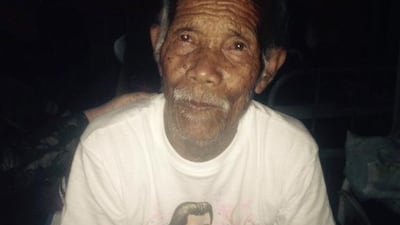Kathmandu // Rescuers have pulled a 101-year-old man alive from the debris of his home a week after Nepal’s earthquake that claimed at least 7,200 lives, as the government warned the death toll would climb “much higher”.
Funchu Tamang was rescued on Saturday with only minor injuries to his ankle and hand.
“He was brought to the district hospital in a helicopter. His condition is stable,” said police officer Arun Kumar Singh from Nuwakot district, about 80 kilometres north-west of Kathmandu.
Police also pulled three women alive from under rubble on Sunday in Sindhupalchowk, one of the districts worst affected by the April 25 earthquake, although it was not clear how long they had been trapped.
The rescues were rare good news for the devastated country after officials on Saturday had ruled out finding more survivors buried in the ruins and the focus shifted to delivering aid to thousands in remote areas.
Nepal’s finance minister Ram Sharan Mahat said the death toll was likely to jump once relief teams reached mountain villages flattened in the worst quake to hit the nation in more than 80 years.
“There are still villages where we know that all houses have been destroyed, but have not yet been able to reach,” Mr Mahat said.
“The aftershocks have not receded and we expect the final casualty numbers to climb much higher,” the minister said, as he appealed for hundreds of millions of dollars in foreign donations to help rebuild the country.
The 7.8-magnitude quake wreaked reduced much of the capital Kathmandu to rubble and triggering a deadly avalanche on Mount Everest.
Although teams of rescuers from more than 20 countries have been using sniffer dogs and heat-seeking equipment to find survivors, no one has been pulled out alive in Kathmandu since Thursday evening.
In the worst-hit districts of Gorkha and Sindhupalchowk, almost 90 per cent of the mostly stone and mud homes have been destroyed, the United Nations said.
“Our priority now is really to try to reach those people, get immediate assistance to them,” the UN’s head of humanitarian affairs Valerie Amos said.
But Ms Amos has said she was worried that the tonnes of foreign aid pouring into Nepal was being held up by red tape.
“I was extremely concerned to hear reports that customs was taking such a long time,” she said, adding that she had asked prime minister Sushil Koirala to speed up clearance for aid materials.
Planes loaded with relief supplies were pouring into landlocked Nepal, but there have been numerous reports of many getting stuck at Kathmandu’s small airport, and customs officials stopping trucks filled with aid from crossing into the country from India.
The airport has been closed to heavy planes due to concern about the condition of the single runway after the quake and a series of strong aftershocks, said Birendra Prasad Shrestha, manager of Tribhuvan International Airport.
“We have issued a notice saying that aircraft with a total weight exceeding 196 tonnes will not be allowed to land at Kathmandu airport,” Mr Shrestha said.
“There are no visible cracks in the runway but there have been so many tremors recently that we have to take precautions – we don’t know what’s happening below the surface.
“This runway is the only lifeline for Kathmandu -- if it goes, everything goes.”
The death toll from the disaster has hit 7,250, according to the emergency operations centre, with more than 14,000 injured. More than 100 were also killed in India and China.
Fifty-one bodies, including those of six foreigners, have been found in the popular Langtang trekking region hit by a quake-triggered avalanche.
“We estimate that about 100 foreigners might still be missing in the area,” said senior local official Uddav Prasad Bhattarai.
“Our priority was to get the survivors out. We rescued over 350 people, about a half of them were tourists or guides,” he said.
* Agence France-Presse

